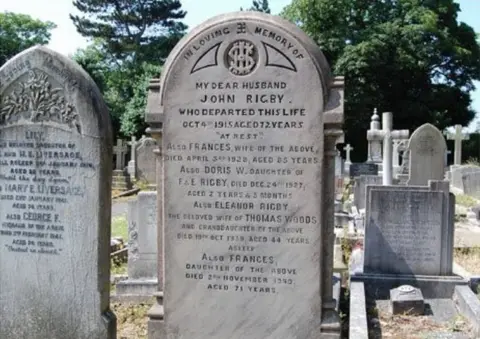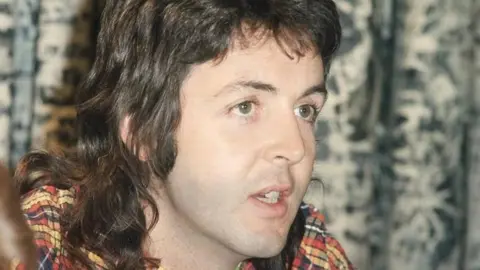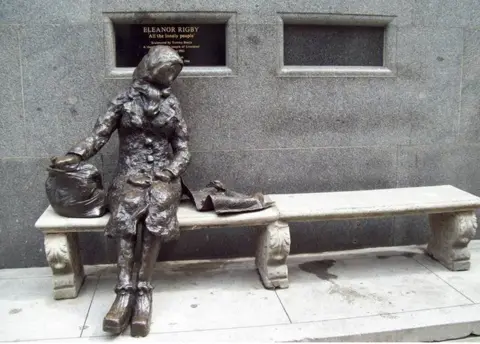The Beatles: What really inspired Eleanor Rigby?
 BBC
BBCIn a graveyard in Liverpool lies a headstone bearing the name Eleanor Rigby. Its deeds are being auctioned later as part of a sale of Beatles memorabilia, but what is the real story behind the Fab Four's famous hit?
It was at a church fete in 1957 that John Lennon and Paul McCartney first met. Just yards away lay the grave of scullery maid Eleanor Rigby, who had died, aged 44, in 1939.
Nine years later, McCartney would pen the lyrics for what became one of the band's most celebrated songs.
Often described as a lament for the lonely, or a commentary on life in post-war Britain, it tells the story of a woman who "died in the church and was buried along with her name".
It is tempting to picture the teenage Lennon and McCartney sombrely contemplating the headstone, imagining the life of Eleanor and later dreaming up the lyrics.
But the reality is few knew of the grave's existence until the early 1980s, and McCartney himself has denied it was the inspiration behind the song.
This hasn't stopped the deeds to the grave being listed for auction with a guide price of £4,000. They are part of a sale which also features other Beatles items and concludes on Thursday.
 Omega auctions
Omega auctionsDavid Bedford, who has written several books about the band, said he thought it was "weird" there was such interest in a woman seemingly unconnected to the song.
"The score of the song you can understand but a grave, I find it really unusual," he said.
"I'm not quite sure who would want to buy the deeds to a grave, and I'll be interested to see who does buy them, and for how much money."
But Mr Bedford said he believed it would be "too much of a coincidence" if the grave had never figured in McCartney's mind, at least at some subliminal level.
"The mythology of the grave grows every year," he said.

Factfile: Eleanor Rigby

- Written primarily by McCartney, Eleanor Rigby was released in 1966 as part of a double A-side single which also featured Yellow Submarine
- The song also formed part of The Beatles' album, Revolver, and the single was released on the same day as the LP
- The single spent four weeks at number one in the UK charts
- In the US it reached number 11 and was nominated for three Grammys

The song seems to have gone through several stages of development.
McCartney said when he first sat down at the piano he had the name Daisy Hawkins in his mind. He later changed this to Eleanor, after the actress Eleanor Bron, who had starred with The Beatles in the film Help!
The character's surname at one stage was Bygraves, according to Spencer Leigh, author of The Beatles book Love Me Do to Love Me Don't.
But McCartney later changed this to Rigby, from the name of a store he had spotted in Bristol - Rigby & Evens Ltd, Wine & Spirit Shippers.
"I just liked the name," he said in 1984. "I was looking for a name that sounded natural. Eleanor Rigby sounded natural."

 Google
GoogleIn 2008, a birth certificate for the woman buried in the graveyard of St Peter's Church, Woolton, was put up for auction.
"Eleanor Rigby is a totally fictitious character that I made up," McCartney said in response.
"If someone wants to spend money buying a document to prove a fictitious character exists, that's fine with me."
However, he has conceded in the past the headstone may have influenced him in a subconscious way.
Mr Leigh said it was easy to see how McCartney's childhood visits to the churchyard would have been very memorable for him.
"John Lennon had connections in that church and had even been in the choir there," he said.
"[Lennon's] uncle died in 1955 when he was quite young. His name was George Toogood Smith. John loved the name and quite often he would take his friends into the graveyard to show them.
"It's quite possible McCartney saw the Rigby grave and just stored it away in his head. It's just possible that he kept that in his mind. But we actually don't know, and I think McCartney himself doesn't know."
 Getty Images
Getty Images PA
PAKaren Fairweather, from Omega Auctions, conceded the connection between the real Eleanor Rigby and the song was a matter of "folklore", none of which was rooted in "concrete fact".
"There is of course the gravestone, and the Rigbys lived on the road that backed on to the road where John Lennon lived," she added.
Yet, whatever the origin of the name, Eleanor Rigby remains an integral part of the band's story and Liverpool's Beatles industry. The gravestone itself is regularly visited by guided tours and an Eleanor Rigby sculpture can be found in Stanley Street.
Mr Leigh describes the song as "perfect", both in its melodies and its representation of a typical Liverpudlian woman of the time.
 John Driscoll/Geograph
John Driscoll/Geograph"The real Eleanor Rigby worked as a sort of scullery maid," Mr Leigh said. "It just fits so perfectly."
He said the jazz singer George Melly put it best when he said: "Eleanor Rigby seemed to be written out of their experiences in Liverpool.
"Liverpool was always in their songs but this was about the kind of old woman that I remembered from my childhood and later: very respectable Liverpool women, living in two-up, two-down streets with the doorsteps meticulously holystoned (scoured) and the church the one solid thing in their lives.
"There's the loneliness of it and it struck me as a poem from the start.
"If you read Love Me Do without the music, it doesn't mean much but if you read Eleanor Rigby, it is a poem about someone, which [was] something unprecedented in popular song."
